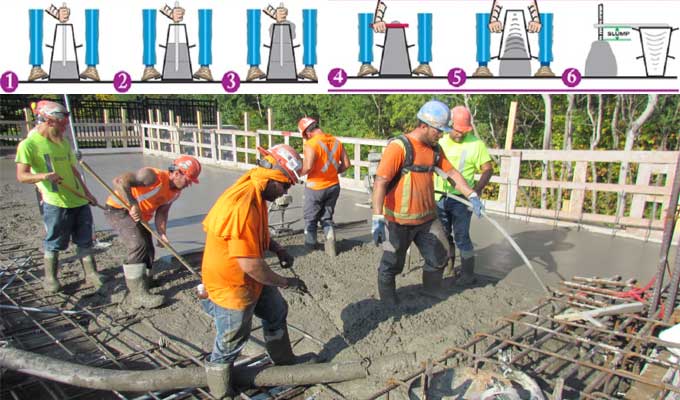
Concrete Strength Testing: 7 Methods with their Advantages & Disadvantages

The schedule of project managers should be considered when selecting a method for monitoring concrete's compressive strength. The strength data may be obtained directly from third-party facilities in some cases and may require extra time in others. Project managers make decisions based on more factors than time alone. It is also crucial to guarantee the accuracy of the test since it directly affects the quality of the concrete.
Methods for Testing Compressive Strength of Concrete
1. Rebound Hammer
When the spring release mechanism works, a hammer deploys, and a plunger is driven into the slab by impact.
This distance is measured from the hammer to the concrete surface and is given a value between 10 and 100. A concrete's strength determines by measuring its density.
Advantage: This process is fairly straightforward and can be done on site.
Disadvantage: Accurate measurements require pre-calibration using cored samples. Those results may be skewed by surface conditions or by large aggregates or rebar located below the testing location.
2. Wireless Maturity Sensors
Concrete strength is a function of its hydration temperature history, according to the theory behind this technique. Wireless sensors are attached to the rebar in the formwork before pouring concrete. The sensor records temperature data, which is uploaded to any smart device via an app. Based on the maturity equation in the app, the in-situ concrete element's compressive strength can be calculated using this information.
Advantage: Real-time compression strength data is given every 15 minutes and updated in real-time. In the form of the sensor, the formwork and concrete are exposed to the same curing condition, so sensor data is considered to be more accurate and reliable. A third-party lab can produce results onsite, eliminating time spent waiting for results.
Disadvantage: The maturity curve of each concrete mix must be established using one-time calibration using cylinder brake tests.
3. Penetration Resistance Test
The penetration resistance test is completed by driving a small pin or probe into the surface of the concrete. It is related to the strength of the in-place concrete, what force was needed to penetrate the surface, and how deep the hole was.
Advantage: The process can be carried out onsite and is relatively simple to use.
Disadvantage: There are significant effects of surface conditions and the type of aggregate used on the data. A pre-calibration using at least three concrete samples is required to obtain accurate strength measurements.
4. Ultrasonic Pulse Velocity
The velocity of vibration energy through a slab can be determined using this technique. It is possible to measure the elasticity, tensile strength, and density of concrete by how easily this energy can travel through the slab. Then, the slab strength can be estimated.
Advantage: Concrete flaws like cracks and honeycombing can also be detected using this non-destructive test.
Disadvantage: The concrete element's moisture content and the presence of reinforcements, aggregates, and reinforcements greatly influence this method. Accurate testing also requires calibration with multiple samples.
5. Pull out Test
Hardened concrete is removed from the slab using a core drill. Afterward, the compressed samples test for strength in a machine.
Advantage: Since the concrete specimens are tested for strength under the same environmental and thermal conditions as the slab in place, these samples are more accurate than field-cured specimens.
Disadvantage: As the slab's structural integrity is damaged, this is a destructive technique. It is necessary to repair the core locations afterward. Strength data must be obtained from a laboratory.
6. Cast in Place Cylinders
The pouring site prepares by placing cylinder molds. Those molds remain in the slab after new concrete has poured into them. Specimens harden, then it compressed to make them stronger.
Advantage: In-place concrete specimens are more accurate than those that are cured in a field.
Disadvantage: The slab is damaged in this way, which compromises its structural integrity. Repairs need to be made to the holes afterward. Strength data must be obtained from a laboratory.
7. Drilled Core
Hardened concrete is removed from the slab using a core drill. Afterward, the compressed samples test for strength in a machine.
Advantage: The thermal history and curing conditions of an in-place slab reflect in field-cured specimens as well as those in laboratory settings.
Disadvantage: The slab is damaged in this way, which compromises its structural integrity. Afterward, It is necessary to repair the areas where the cores are located. Laboratories must measure strength.
Conclusion
Your choice of testing method may be based on what you are accustomed to. Although these tests are generally accurate, the time it takes to get strength data is generally overlooked as a factor that should be taken into consideration. When building a project, consider where your money and time go.
Concrete structures can be affected by the accuracy of the technique you choose in the future. The longer it takes to receive strength data, the more likely it is that your deadlines will be missed, negatively impacting productivity on your jobsite. A good tool might even allow you to finish the project below budget and improve timelines.


